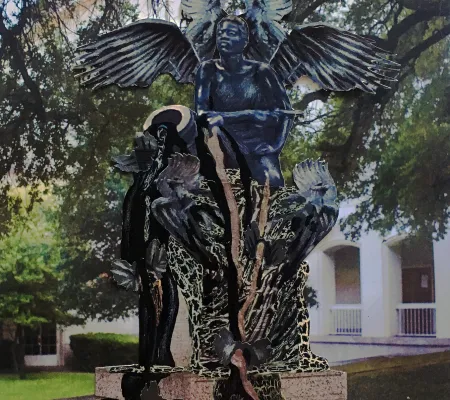What should replace statues celebrating the Confederacy?
The New York Times Opinion section asked the question of what to do when Confederate monuments have been removed, much like the Jefferson Davis, Robert E. Lee, Albert Sidney Johnston, John Reagan and James Stephen Hogg statues have been removed from the Main Mall on The University of Texas at Austin’s campus. In thinking of new alternatives to take the place of old monuments, the New York Times called upon six artists to re-imagine what could be. Among them were Studio Art Professor Nicole Awai and MFA candidate Ariel Jackson.
Nicole Awai imagined a statue inspired by the Soldiers and Sailors Memorial Arch that stands at Grand Army Plaza at the main entrance to Prospect Park in Brooklyn. “It includes the figure of a crouching African-American man who seems to be surveying and assessing the battle situation,” writes Awai in the New York Times piece. “He is confidently poised, holding his gun with his arm comfortably propped up across his knee next to a cannon, calmly awaiting the action to come. He is never a victim. For me he is truly an alchemist, a person who transforms or creates through a seemingly magical process, who has the power to transform things for the better.” This figure would inspire a replacement for a monument (formerly) located on UT Austin’s Main Mall and titled, “The Spirit of Persistent Resistance of the Liquid Land.”
This figure of the crouching male also made an appearance in another work Awai exhibited in a group show, Alchemy, at BRIC in Brooklyn. In a review from Hyperallergic, Seph Rodney writes, “On second thought, ‘Persistent Resistance’ may not really be a monument or memorial. It might be more like a wellspring. Awai’s alchemic enchantment might be creating these floating spirit beings out of the tar and asphalt that has bubbled up from the earth. In this case, the work suggests that the spirit that enlivens this unique order of guardians also animates that faithful African-American soldier who still remains at his post watching for the battle he knows is coming.”
Awai’s work could also be found this past summer at Lesley Heller Gallery in the group show Picnic as well as discussed within Dr. Marsha Pearce’s paper presentation, 'Picturing Theory': Nicole Awai's Black Ooze as Post Diaspora Expression during the Caribbean Women (Post) – Diaspora: African/Caribbean Interconnections conference at London South Bank University in July.
UT MFA candidate Ariel Jackson also re-conceptualized a monument in place of the Beauregard monument taken down in her hometown of New Orleans. For the piece, Jackson drew inspiration from the native Live Oak trees of New Orleans, which she interpreted as both a marker of historical past and future, and a symbol of embraced diversity.
“When I imagine a replacement monument that reflects the diversity and creolization of New Orleans, I imagine an abstract Live Oak tree interpreted four ways, with each version covered in a soil type that is found in Louisiana,” writes Jackson. “Driving on the roundabout, passers-by see the Live Oak Tree in its three-dimensionality. Each side has a unique look, but they all come together, forming a kind of family tree.”
New work by Jackson was featured for Original Language, a group show at the CUE Art Foundation curated by Natasha Marie Llorens. "Ghost Image: (Re)Creation and (Re)Understanding" joined the work of six other artists invested in the relationship between language and violence. From the press release, “The work maps a range of responses to the paradoxical fact that while it is urgent and necessary to use language in protest, language is also routinely the very site of structural violence.”
In "Ghost Image: (Re)Creation and (Re)Understanding", there are images projected onto both sides of a free-standing blackboard, showing Jackson drawing a diagram as though she were lecturing a class. “Drawing both from Judith Carney’s work on the transmission of African farming techniques during slavery and from her own grandfather’s mechanical library, Jackson renders the history of knowledge lost, recovered, and transformed through several generations of African Americans in the South.”
[[{"fid":"1829","view_mode":"full_width","fields":{"format":"full_width","field_file_image_alt_text[und][0][value]":"image of documentation of a performance where a man is dancing and a woman is speaking"},"type":"media","field_deltas":{"2":{"format":"full_width","field_file_image_alt_text[und][0][value]":"image of documentation of a performance where a man is dancing and a woman is speaking"}},"attributes":{"alt":"image of documentation of a performance where a man is dancing and a woman is speaking","class":"media-element file-full-width","data-delta":"2"}}]]
Ariel Jackson and Michael Love, All I See is Blue, 2018
In addition to the sculptural work exhibited in Original Language, Jackson also performed All I See is Blue on Sept. 8, 2018 with UT MFA candidate in Performance as Public Practice Michael Love. Currently, Jackson is studying at the Royal College of Art in London as part of the UT<>RCA Reciprocal Exchange Program.


